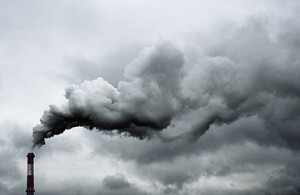東京電力と政府は、福島第一原発事故から3年が経っても、いまだに福島の状況についての正確な情報を公開せず、国内だけでなく世界中から批判を浴び続けています。同じように、石炭火力をはじめとする発電所に関する情報についても、政府と電力会社による情報公開はまったく十分ではなく、国内の石炭火力発電の現状を評価することがほとんどできない状況です。例えば、CO2やSOx(硫黄酸化物)、NOx(窒素酸化物)、水銀、PM2.5の排出量や、使われている発電技術、発電効率に関する実データは、ほとんど手に入れることはできません。
一方アメリカでは、まったく状況が異なっています。アメリカ合衆国環境保護庁(EPA)のAir Markets Program Data (AMPD)では、米国内の全ての発電所の情報を開示していて、1時間毎の詳細データでさえ、誰でもウェブサイトから入手することができるのです。CO2やNOx, SOx、水銀などの汚染物質に関する実排出量の情報も得られるため、各発電所が健康や環境にどれくらい影響を及ぼしているのか知るのに非常に役立つものです。このようなプログラムがあるのはアメリカだけではなく、例えばEUには、汚染物質排出移動登録制度があります。どちらのケースでも、各発電所は、毎年排出量を報告することが義務付けられています。
1月には、いまや世界最大のCO2排出国(とはいえ、一人当たりの排出量は世界1位からほど遠いのですが)となった中国が、排出量の多い約15,000の事業所(発電所を含む)を対象に、SOxやNOxなどの排出量の実績値を報告することを求めると発表しました。すでにいくつかの発電所については、情報が公開されています(例:浙江省の発電所)
情報公開に関しては、2003年、気候ネットワークは、事業者のエネルギー消費量や電力消費に関する情報開示を求めて政府を相手に裁判を起こしましたが、その戦いは困難なものでした。地方裁判所(名古屋、大阪、東京)では勝訴し、高裁でも名古屋、東京で勝訴したものの、大阪高裁は地裁の判決を覆して訴えを棄却。そして最高裁は、3事件を合わせて企業が公開を拒否する場合には、政府は情報を開示しなくてもよいとの判決を下しました。気候ネットワークの訴訟を通してプレッシャーが高まった結果、温室効果ガス排出量算定報告公表制度の導入への道が開かれましたが、各事業所のエネルギーと電力消費に関する情報は、十分に市民に開かれているとは言えません。
日本では電力会社は石炭は「クリーンだ」と主張しますが、情報の自由がなくして、どうやってそれを確かめることができるというのでしょうか?先進国であり、民主主義の国である日本には、アメリカやEU、中国のような情報開示プログラムがあって然るべきです。電力会社が排出する有害物質の中身を知ることができるようになるのは、単に時間の問題でしょうか?それとも…?
出典:
ニューヨークタイムズ :原発事故、避難指示解除も住民は帰宅に消極的 (2014年4月27日)
http://www.nytimes.com/2014/04/28/world/asia/forced-to-flee-radiation-fearful-japanese-villagers-are-reluctant-to-return.html?_r=0
アメリカ合衆国環境保護庁
http://www.epa.gov/
アメリカ合衆国環境保護庁 Air Markets Program Data、2014
http://ampd.epa.gov/ampd/
欧州委員会
http://ec.europa.eu/index_en.htm
欧州委員会、汚染物質排出移動登録制度
http://prtr.ec.europa.eu/PollutantReleases.aspx
天然資源保護協議会:中国、深刻な大気汚染との戦い 新たな対策で改善を図る(2014年1月14日)
http://switchboard.nrdc.org/blogs/lgreer/china_fights_back_against_airpocalypse_embarking_on_a_new_air_pollution_initiative_that_just_might_work.html
EDGAR:CO2排出量のトレンドレポート(2013年版)
http://edgar.jrc.ec.europa.eu/news_docs/pbl-2013-trends-in-global-co2-emissions-2013-report-1148.pdf
Lord, Richard, Silke Goldberg, Lavanya Rajamani, Jutta Brunnee Eds.気候変動の責任 国際法と実践、ケンブリッジ大学プレス、2012
気候ネットワーク:企業の各事業所の温室効果ガスの排出実態~省エネ法に基づくデータ分析の結果発表~(2004/06/02)
goo.gl/lE9XYt
It is no secret in Japan and around the world that in the three years since the Fukushima Dai-ichi nuclear power plant accident, Tokyo Electric Power Company (TEPCO) and the government have been hounded by accusations of withholding pertinent information about the situation in disaster-struck Fukushima. It comes to no surprise that information available for power plants, such as coal power plants, by utility companies and the government is scant, if any at all, making it near impossible to make any assessments about the conditions of Japan’s domestic coal fleet. For example, actual data of CO2, SOx, NOx, mercury and PM2.5 emissions, the technology used and the operating efficiency of each plant is largely unavailable.
In sharp contrast, the US Environmental Protection Agency’s Air Markets Program Data (AMPD) allows anyone to look up any power plant in the country and obtain detailed hourly data. Acquiring information about pollutants such as CO2, NOx, SOx and Mercury from this program can contribute greatly in knowing a plant’s impact on health and the environment. Similar programs can be seen in other parts of the world such as the European Union with its European Pollutant Release and Transfer Register (E-PRTR). In both cases, facilities must report their annual emissions to these programs. China, the biggest emitter of CO2 (although it ranks much lower in terms of emissions per capita), announced in January that it will require approximately 15,000 of its largest facilities (including power plants) to report their actual air emissions such as sulfur dioxide and nitrous oxide for each plant some of which is now available for public viewing (here is just one example from Zhejiang province).
Getting the government to disclose energy and electricity data for large facilities in Japan has been an uphill battle. Starting in 2003, climate change NGO Kiko Network took the Japanese government to court on 3 occasions (in 3 districts) to fight for disclosure of energy and electricity consumption data for large facilities. Although Kiko Network won in the district courts (Nagoya, Osaka and Tokyo), the Osaka high court revoked the judgment made by its district court. The Supreme Court then declared that the government can refuse to disclose information if some companies have concerns. We now have a GHG accounting system, which was introduced as a result of increased pressure through Kiko Network’s lawsuit but further information on aspects such as energy and electricity for each facility, is out of reach.
Without freedom of information, how can we confirm that the coal plants in our country are as “clean” as utilities claim? Seeing as Japan is a developed, democratic country, it is only natural that Japan is expected to have a similar program. Will it just be a matter of time before we can know the content of the toxic plumes emitted by utilities?
Sources:
The New York Times, Forced to Flee Radiation, Fearful Japanese Villagers are Reluctant to Return, April 27th, 2014
http://www.nytimes.com/2014/04/28/world/asia/forced-to-flee-radiation-fearful-japanese-villagers-are-reluctant-to-return.html?_r=0
United States Environmental Protection Agency
http://www.epa.gov/
United States Environmental Protection Agency, Air Markets Program Data, 2014
http://ampd.epa.gov/ampd/
European Commission
http://ec.europa.eu/index_en.htm
European Commission, The European Pollutant Release and Transfer Register
http://prtr.ec.europa.eu/PollutantReleases.aspx
The Natural Resources Defense Council, China Fights Back Against Airpocalypse: A new air pollution initiative that just might work!, January 14th, 2014
http://switchboard.nrdc.org/blogs/lgreer/china_fights_back_against_airpocalypse_embarking_on_a_new_air_pollution_initiative_that_just_might_work.html
EDGAR, Trends in CO2 emissions – 2013 Report, EDGAR
http://edgar.jrc.ec.europa.eu/news_docs/pbl-2013-trends-in-global-co2-emissions-2013-report-1148.pdf
Lord, Richard, Silke Goldberg, Lavanya Rajamani, Jutta Brunnee Eds., Climate Change Liability: Transnational Law and Practice, Cambridge University Press, 2012
Kiko Network, CO2 emission data at each factory is revealed for the first time, October 15th, 2004
http://www.kikonet.org/eng/news-archive-en/2004-10-15


